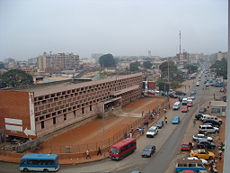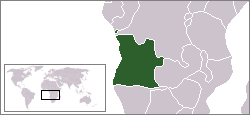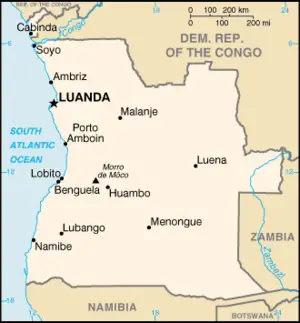Angola
| República de Angola | ||||||
|---|---|---|---|---|---|---|
|
||||||
| Motto: none | ||||||
| Anthem: Angola Avante! (Portuguese: Forward Angola!) |
||||||
| Capital (and largest city) | Luanda 8°50′S 13°20′E | |||||
| Official languages | Portuguese | |||||
| Government | Multi-party democracy | |||||
| Independence | ||||||
| Area | ||||||
| - | Total | 1,246,700 km² (22nd) Expression error: Unexpected div operator. sq mi |
||||
| - | Water (%) | Negligible | ||||
| Population | ||||||
| - | 2004 estimate | 10,978,552 (71st) | ||||
| - | ? census | unavailable | ||||
| GDP (PPP) | 2003 estimate | |||||
| - | Total | 31,3641 (83) | ||||
| - | Per capita | 2,319 (120) | ||||
| Currency | Kwanza (AOA) |
|||||
| Time zone | CET (UTC+1) | |||||
| - | Summer (DST) | not observed (UTC+1) | ||||
| Internet TLD | .ao | |||||
| Calling code | +244 | |||||
| 1 Estimate is based on regression; other PPP figures are extrapolated from the latest International Comparison Programme benchmark estimates. | ||||||
A former Portuguese colony, Angola, known formally as the Republic of Angola, has been ravaged by a quarter-century of civil war and dominated by a Marxist-style government since independence. The name Angola is a Portuguese derivation of the Bantu word N’gola, being the title of the native rulers of the Quimbundos Kingdom in the sixteenth century. It has considerable natural resources, among which oil and diamonds are the most relevant.
The oil-rich exclave province of Cabinda borders both the Republic of the Congo and the Democratic Republic of the Congo. The latter's only oceanic access, XX miles (60 km) in width, divides Angola from Cabinda. The population stands at around 300,000, two-thirds of which inhabit the surroundings in a generally stable state on Congolese and Zairian territory. The Angolan central government has yet to quell the Cabindese secessionist movement.
History
Present-day Angola was settled in 1483 at the river Congo, where the Kongo State, Ndongo and Lunda existed. The Kongo State stretched from modern Gabon in the north to the Kwanza River in the south. Portugal established a colony at Luanda in 1575, based on the slave trade. The Portuguese gradually took control of the coastal strip throughout the sixteenth century by a series of treaties and wars and then formed the colony of Angola. The Dutch occupied Luanda from 1641 to 1648, providing a boost for anti-Portuguese states. But in 1648 Portugal retook Luanda and initiated a process of military conquest of the Kongo and Ndongo states that ended with Portuguese victory in 1671. Full Portuguese administrative control of the interior did not occur until the beginning of the twentieth century. In 1951 the colony was restyled as an overseas province, also called Portuguese West Africa. When Portugal refused a decolonization process three independence movements emerged:
- the Popular Movement for the Liberation of Angola (Movimento Popular de Libertação de Angola MPLA), with a base among Kimbundu and the mixed-race intelligentsia of Luanda and links to communist parties in Portugal and the Soviet bloc;
- the National Liberation Front of Angola (Frente Nacional de Libertação de Angola, FNLA), with an ethnic base in the Bakongo region of the north and links to the United States and the Mobutu regime in Zaire; and
- the National Union for Total Independence of Angola (União Nacional para a Independência Total de Angola, UNITA), led by Jonas Malheiro Savimbi with an ethnic and regional base in the Ovimbundu heartland in the center of the country.
After a fourteen-year independence guerrilla war and the overthrow of Portugal's government by a military coup, Angola's nationalist parties began to negotiate for independence in January 1975. Independence was set for November 1975, but almost immediately, a civil war broke out among the MPLA, UNITA, and the FNLA, exacerbated by foreign intervention. South African troops struck an alliance of convenience with UNITA and invaded Angola in August 1975 to ensure that there would be no interference (by a newly independent Angolan state) in Namibia, which was then under South African control. Cuban troops came to the support of the MPLA in October 1975, enabling them to control the capital, Luanda, and hold off the South African forces. The MPLA declared itself the de facto government of the country when independence was formally declared in November, with Agostinho Neto as the first president.
In 1976, the FNLA was defeated by a combination of MPLA and Cuban troops, leaving the Marxist MPLA and UNITA (backed by the United States and South Africa) to fight for power.
The conflict raged on, fueled by the geopolitics of the Cold War and by the ability of both parties to access resources from Angola's natural resources. The MPLA drew upon the revenues of off-shore oil reserves, while UNITA accessed alluvial diamonds that were easily smuggled through the region's very porous borders.
In 1991, the factions agreed to turn Angola into a multiparty state, but after the current president José Eduardo dos Santos of MPLA won UN-supervised elections, UNITA claimed there was fraud and fighting broke out again. A 1994 peace accord (Lusaka protocol) between the government and UNITA provided for the integration of former UNITA insurgents into the government. A national unity government was installed in 1997, but serious fighting resumed in late 1998, rendering hundreds of thousands of people homeless.
On February 22, 2002, UNITA's leader, Jonas Savimbi,was shot dead and a cease-fire was reached by the two factions. UNITA gave up its armed wing and assumed the role of major opposition party. Although the political situation of the country seems to be normalizing, President dos Santos still has not allowed regular democratic processes.
Among Angola's major problems are a serious humanitarian crisis as a result of the prolonged war, the abundance of mine fields, and continued violence by guerrilla movements fighting for the independence of the northern enclave of Cabinda (Frente para a Libertação do Enclave de Cabinda).
Angola, like many sub-Saharan nations, is subject to periodic outbreaks of infectious diseases. As of early April 2005, Angola was in the midst of an outbreak of the Marburg virus, which is rapidly becoming the worst outbreak of a hemmorhagic fever in recorded history, with over 237 deaths recorded out of 261 reported cases. It had spread to seven of the eighteen provinces as of 2005.
Politics
The executive branch of the government is composed of the president, the prime minister, and a Council of Ministers. Currently, political power is concentrated in the presidency. The Council of Ministers, composed of all government ministers and vice ministers, meets regularly to discuss policy issues. Governors of the eighteen provinces are appointed by and serve at the pleasure of the president. The Constitutional Law of 1992 establishes the broad outlines of government structure and delineates the rights and duties of citizens. The legal system is based on Portuguese and customary law but is weak and fragmented, and courts operate in only 12 of more than 140 municipalities. A Supreme Court serves as the appellate tribunal; a Constitutional Court with powers of judicial review has never been constituted despite statutory authorization.
The 27-year-long civil war ravaged the country's political and social institutions. The United Nations estimates there are 1.8 million internally displaced persons , while the accepted figure for war-affected people is 4 million. Daily conditions of life throughout the country and specifically Luanda (population approximately 4 million) mirror the collapse of administrative infrastructure as well as many social institutions. The ongoing grave economic situation largely prevents any government support for social institutions. Hospitals lack medicines or basic equipment, schools operate without books, and public employees often do without basic supplies for their day-to-day work.
The president has announced the government's intention to hold elections in 2006. These elections would be the first since 1992 and would serve to elect both a new president and a new National Assembly.
Geography
Angola is bordered by Namibia to the south, Zambia to the east, the Democratic Republic of the Congo to the northeast, and the South Atlantic Ocean to the west. The exclave of Cabinda also borders the Republic of the Congo to the north. Angola's capital, Luanda, lies on the Atlantic coast in the northwest of the country.
Angola is divided into an arid coastal strip stretching from Namibia to Luanda; a wet, interior highland; a dry savanna in the interior south and southeast; and rain forest in the north and in Cabinda. The Zambezi River and several tributaries of the Congo River have their sources in Angola.
Economy
Angola is an economy in disarray because of a quarter century of nearly continuous warfare. Despite its abundant natural resources, output per capita is among the world's lowest. Subsistence agriculture provides the main livelihood for 85 percent of the population. Oil production and its supporting activities are vital to the economy, contributing about 45 percent of GDP and 90 percent of exports. Control of the oil industry is consolidated in Sonangol Group, a conglomerate which is owned by the Angolan government. Notwithstanding the signing of a peace accord in November 1994, violence continues, millions of land mines remain, and many farmers are reluctant to return to their fields. As a result, much of the country's food must still be imported. Despite the increase in the pace of civil warfare in late 1998, the economy grew by an estimated 4 percent in 1999. The government introduced new currency denominations in 1999, including a 1 and 5 kwanza note. Expanded oil production brightens prospects for 2000, but internal strife discourages investment outside the petroleum sector.
With the advent of peace in 2002 a strategic partnership with China was set in motion, so huge investments by Chinese companies are now in place, especially in the construction sector and more recently in the metallurgical sector.
Demographics

Angola has three main ethnic groups, each speaking a Bantu language: Ovimbundu 37 percent, Kimbundu 25 percent, and Bakongo 13 percent. Other groups include Chokwe (or Lunda), Ganguela, Nhaneca-Humbe, Ambo, Herero, and Xindunga. In addition, mestiços (Angolans of mixed European and African family origins) amount to about 2 percent, with a small (1 percent) population of whites, mainly ethnically Portuguese. Portuguese make up the largest non-Angolan population, with at least 30,000 (though many native-born Angolans can claim Portuguese nationality under Portuguese law). Portuguese is both the official and predominant language, spoken in the homes of about two-thirds of the population, and as a secondary language by many more.
The great majority of the inhabitants are of Bantu stock with some admixture in the Congo district. In the southeast are various tribes of Bushmen. The best-known of the Bantu tribes are the Ba-Kongo (Ba-Fiot), who dwell chiefly in the north, and the Abunda (Mbunda, Ba-Bundo), who occupy the central part of the province, which takes its name from the Ngola tribe of Abunda. Another of these tribes, the Bangala, living on the west bank of the upper Kwango, must not be confused with the Bangala of the middle Congo. In the Abunda is a considerable strain of Portuguese blood. The Ba-Lunda inhabit the Lunda district. Along the upper Kunene and in other districts of the plateau are settlements of Boers, the Boer population being about 2,000. In the coast towns the majority of the white inhabitants are Portuguese. The Mushi-Kongo and other divisions of the Ba-Kongo retain curious traces of the Christianity professed by them in the sixteenth and seventeenth centuries and possibly later. Crucifixes are used as potent fetish charms or as symbols of power passing down from chief to chief; every native has a "Santu" or Christian name and is dubbed dom or dona. Fetishism is the prevailing religion throughout the province. The dwelling places of the natives are usually small huts of the simplest construction, used chiefly as sleeping area; the day is spent in an open space in front of the hut, protected from the sun by a roof of palm or other leaves.
Catholicism remains the dominant religion, although an increasing number of churches are claiming more followers, particularly evangelicals.
Culture
Government
- Republic of Angola official government portal
- National Assembly of Angola official site (in Portuguese)
- Embassy of Angola in Washington DC government information and links
News
- allAfrica - Angola news headline links
- Angola Press government-controlled news agency (in Portuguese, French and English)
- Angonoticias (in Portuguese) - A popular news source in Angola
Overviews
- BBC - Country profile: Angola
- CIA World Factbook - Angola
- US State Department - Angola includes Background Notes, Country Study and major reports
Directories
- Columbia University Libraries - Angola directory category of the WWW-VL
- Open Directory Project - Angola directory category
- Stanford University - Africa South of the Sahara: Angola directory category
- Yahoo! - Angola directory category
Other
Credits
New World Encyclopedia writers and editors rewrote and completed the Wikipedia article in accordance with New World Encyclopedia standards. This article abides by terms of the Creative Commons CC-by-sa 3.0 License (CC-by-sa), which may be used and disseminated with proper attribution. Credit is due under the terms of this license that can reference both the New World Encyclopedia contributors and the selfless volunteer contributors of the Wikimedia Foundation. To cite this article click here for a list of acceptable citing formats.The history of earlier contributions by wikipedians is accessible to researchers here:
The history of this article since it was imported to New World Encyclopedia:
Note: Some restrictions may apply to use of individual images which are separately licensed.


